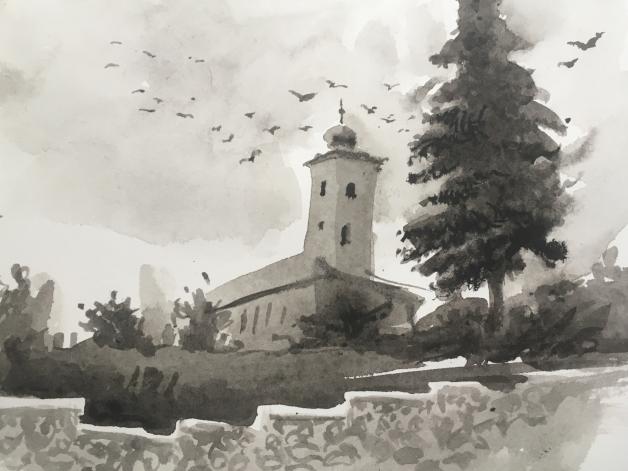By Greta Chiocchetti
Chris Canga carefully sketches a winding cobblestoned path, pausing to add shading where it meets a sky-scraping castle at the top of a hill. Beneath it, a steel gate opens to an eerie, centuries-old cemetery. Above, the School of Illustration instructor recreates the ominously cloudy gray sky with confident brush strokes.
As he recreates the landscape in front of him, his students are capturing it in their own unique styles. One student shows off her watercolor rendition of the spooky scene, complete with an ominous flock of crows soaring through the gray clouds. Another is working with ink, which creates a dramatic contrast of black and white.
“Time’s up,” Canga announces when the 30-minute timer goes off. “Let’s walk down the road a little for our next scene.”
That earns a chuckle from a few members of the audience. The Location Sketching Workshop attendees, a mix of Canga’s past and current students, fellow Academy of Art University instructors, and social media-famous artists can’t physically walk down that road with Canga.
They are drawing on location in Romania, despite the pandemic forcing the world to shelter at home—they’re just doing it digitally with the assistance of Google Earth, via Zoom.
Throughout the three-hour workshop each Friday, participants will sketch five different scenes, which Canga scouts ahead of time. So far, Canga’s workshops have brought the group to locations in Japan, Puerto Rico, Romania, Russia, and Greece.
“The advantage to doing this digitally is that we can go places like, I don’t know, Chernobyl, in Russia—we aren’t just limited to drawing what’s in our backyard,” said Canga. “I usually choose locations based on their visual interest, but I also want to get a sense of the vibe of that place; I want to draw the real essence of what it is to live there, not just the tourist traps.”
Though they feel more like a hangout than work, Canga’s workshops are designed to help students see their skills progress. Location drawing requires artists to practice sketching several different elements at once, and repetition is the best way to see improvement over time.
“They’re so happy when they grow,” said Canga. “It’s like the excitement of a little kid, where they measure up, you know, ‘I did grow! I can see I grew an inch!’”
While many are eager to return to on-site learning, some students say that the digital workshops have unexpected advantages. Omar Gomet, a visual development student, says that the Zoom format can make it less intimidating to engage and ask questions.
“It gives you the chance to be heard and to talk one-on-one with the [instructor],” said Gomet. “Usually in person, a lot of people can be shy.”
Apart from simply sharpening their technical drawing skills, those who tune in each week find that the workshop is a place to build community, especially during these isolating times.
“Chris said artists are energy vampires and it’s totally true—I need to be around the creative energy of other artists in order to keep my own creative juices flowing!” said Abigail Lashbrook, a previous student of Canga’s who earned her B.F.A. in illustration in 2018. “Since we’re all in social isolation right now, this kind of meeting is the best option going right now.”
Join an upcoming Location Sketching Workshop: Fridays, 1 p.m. to 4 p.m., on Zoom.
